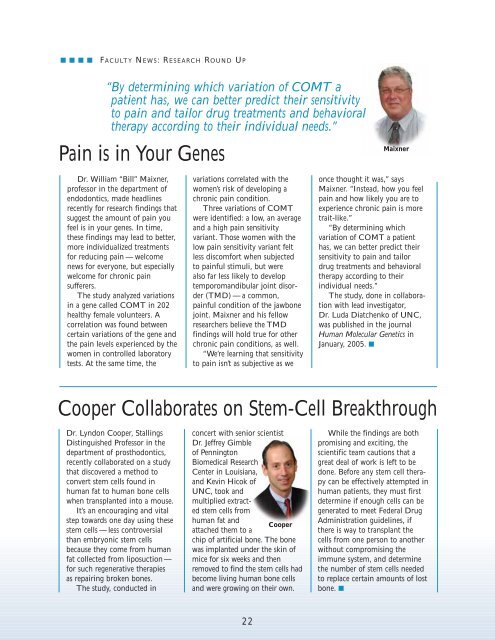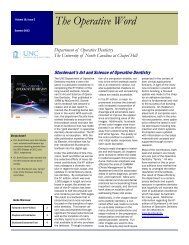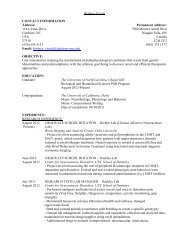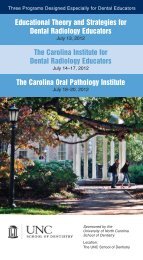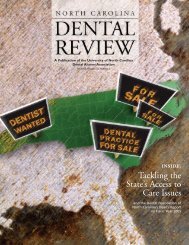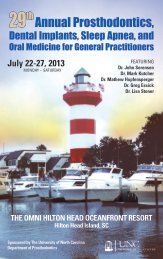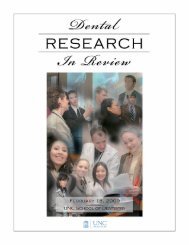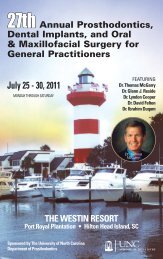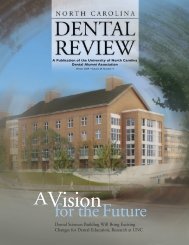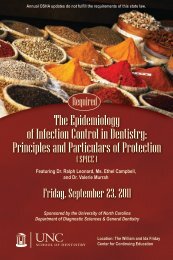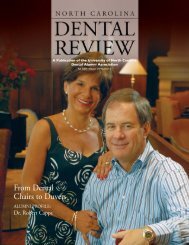A Publication of the University of North Carolina - UNC School of ...
A Publication of the University of North Carolina - UNC School of ...
A Publication of the University of North Carolina - UNC School of ...
Create successful ePaper yourself
Turn your PDF publications into a flip-book with our unique Google optimized e-Paper software.
■■■■<br />
FACULTY N EWS:RESEARCH ROUND U P<br />
“By determining which variation <strong>of</strong> COMT a<br />
patient has, we can better predict <strong>the</strong>ir sensitivity<br />
to pain and tailor drug treatments and behavioral<br />
<strong>the</strong>rapy according to <strong>the</strong>ir individual needs.”<br />
Pain is in Your Genes<br />
Maixner<br />
Dr. William “Bill” Maixner,<br />
pr<strong>of</strong>essor in <strong>the</strong> department <strong>of</strong><br />
endodontics, made headlines<br />
recently for research findings that<br />
suggest <strong>the</strong> amount <strong>of</strong> pain you<br />
feel is in your genes. In time,<br />
<strong>the</strong>se findings may lead to better,<br />
more individualized treatments<br />
for reducing pain — welcome<br />
news for everyone, but especially<br />
welcome for chronic pain<br />
sufferers.<br />
The study analyzed variations<br />
in a gene called COMT in 202<br />
healthy female volunteers. A<br />
correlation was found between<br />
certain variations <strong>of</strong> <strong>the</strong> gene and<br />
<strong>the</strong> pain levels experienced by <strong>the</strong><br />
women in controlled laboratory<br />
tests. At <strong>the</strong> same time, <strong>the</strong><br />
variations correlated with <strong>the</strong><br />
women’s risk <strong>of</strong> developing a<br />
chronic pain condition.<br />
Three variations <strong>of</strong> COMT<br />
were identified: a low, an average<br />
and a high pain sensitivity<br />
variant. Those women with <strong>the</strong><br />
low pain sensitivity variant felt<br />
less discomfort when subjected<br />
to painful stimuli, but were<br />
also far less likely to develop<br />
temporomandibular joint disorder<br />
(TMD) — a common,<br />
painful condition <strong>of</strong> <strong>the</strong> jawbone<br />
joint. Maixner and his fellow<br />
researchers believe <strong>the</strong> TMD<br />
findings will hold true for o<strong>the</strong>r<br />
chronic pain conditions, as well.<br />
“We’re learning that sensitivity<br />
to pain isn’t as subjective as we<br />
once thought it was,” says<br />
Maixner. “Instead, how you feel<br />
pain and how likely you are to<br />
experience chronic pain is more<br />
trait-like.”<br />
“By determining which<br />
variation <strong>of</strong> COMT a patient<br />
has, we can better predict <strong>the</strong>ir<br />
sensitivity to pain and tailor<br />
drug treatments and behavioral<br />
<strong>the</strong>rapy according to <strong>the</strong>ir<br />
individual needs.”<br />
The study, done in collaboration<br />
with lead investigator,<br />
Dr. Luda Diatchenko <strong>of</strong> <strong>UNC</strong>,<br />
was published in <strong>the</strong> journal<br />
Human Molecular Genetics in<br />
January, 2005. ■<br />
Cooper Collaborates on Stem-Cell Breakthrough<br />
Dr. Lyndon Cooper, Stallings<br />
Distinguished Pr<strong>of</strong>essor in <strong>the</strong><br />
department <strong>of</strong> prosthodontics,<br />
recently collaborated on a study<br />
that discovered a method to<br />
convert stem cells found in<br />
human fat to human bone cells<br />
when transplanted into a mouse.<br />
It’s an encouraging and vital<br />
step towards one day using <strong>the</strong>se<br />
stem cells —less controversial<br />
than embryonic stem cells<br />
because <strong>the</strong>y come from human<br />
fat collected from liposuction—<br />
for such regenerative <strong>the</strong>rapies<br />
as repairing broken bones.<br />
The study, conducted in<br />
concert with senior scientist<br />
Dr. Jeffrey Gimble<br />
<strong>of</strong> Pennington<br />
Biomedical Research<br />
Center in Louisiana,<br />
and Kevin Hicok <strong>of</strong><br />
<strong>UNC</strong>, took and<br />
multiplied extracted<br />
stem cells from<br />
human fat and<br />
Cooper<br />
attached <strong>the</strong>m to a<br />
chip <strong>of</strong> artificial bone. The bone<br />
was implanted under <strong>the</strong> skin <strong>of</strong><br />
mice for six weeks and <strong>the</strong>n<br />
removed to find <strong>the</strong> stem cells had<br />
become living human bone cells<br />
and were growing on <strong>the</strong>ir own.<br />
While <strong>the</strong> findings are both<br />
promising and exciting, <strong>the</strong><br />
scientific team cautions that a<br />
great deal <strong>of</strong> work is left to be<br />
done. Before any stem cell <strong>the</strong>rapy<br />
can be effectively attempted in<br />
human patients, <strong>the</strong>y must first<br />
determine if enough cells can be<br />
generated to meet Federal Drug<br />
Administration guidelines, if<br />
<strong>the</strong>re is way to transplant <strong>the</strong><br />
cells from one person to ano<strong>the</strong>r<br />
without compromising <strong>the</strong><br />
immune system, and determine<br />
<strong>the</strong> number <strong>of</strong> stem cells needed<br />
to replace certain amounts <strong>of</strong> lost<br />
bone. ■<br />
22


